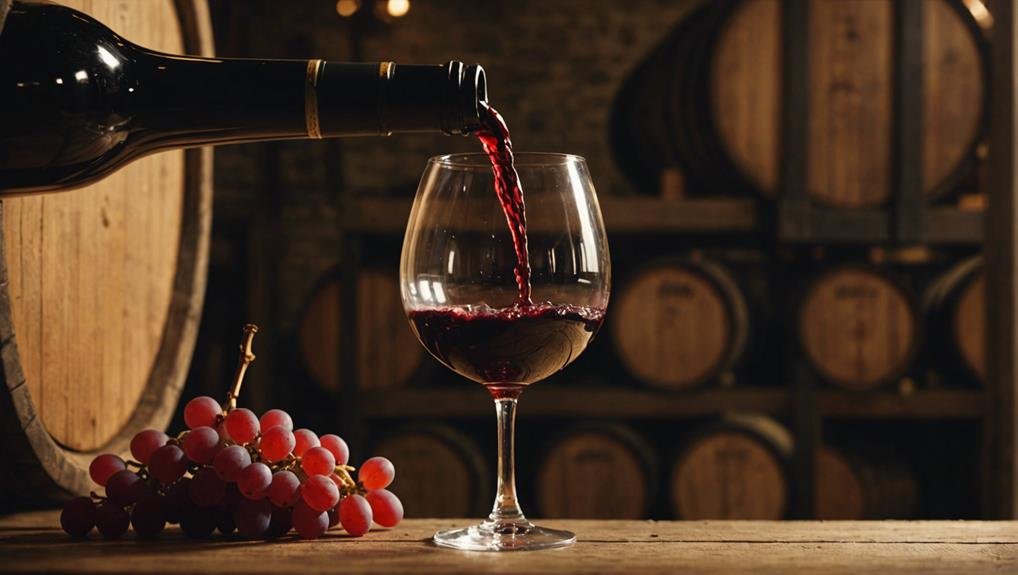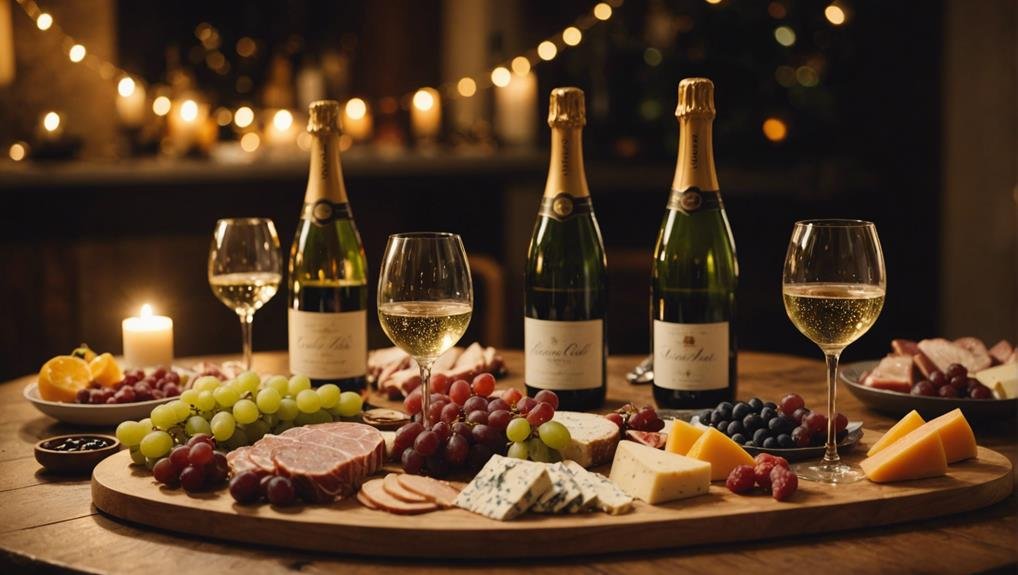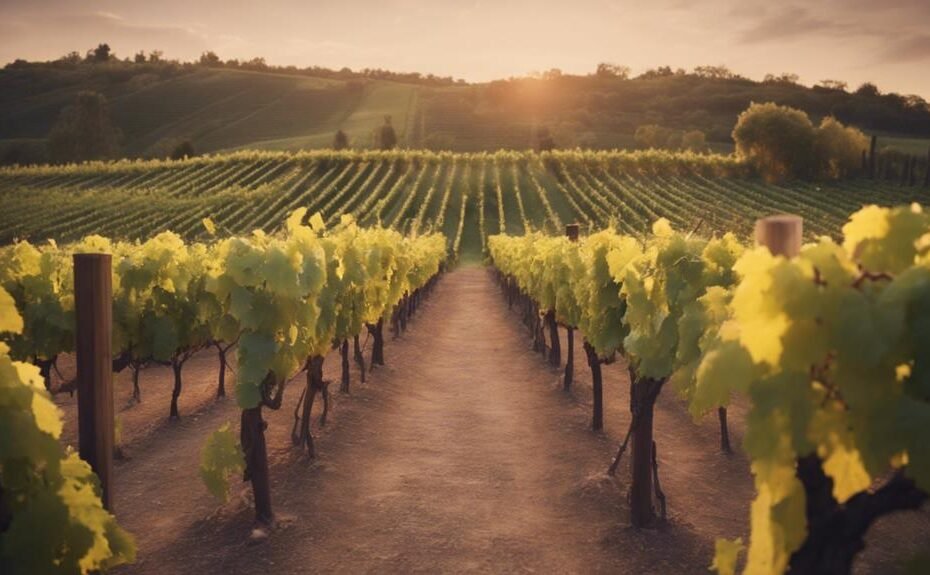Embarking on a journey to develop your wine palate is a fun and rewarding experience.
We'll start with sweet wines like German Riesling and Hungarian Tokaji, which pair well with desserts.
Next, try fruit-forward reds such as Zinfandel and Malbec, which are great for beginners.
As your tastes evolve, explore bolder wines like Cabernet Sauvignon and Syrah, which complement hearty meals.
For a touch of elegance, try Pinot Noir and Chablis, known for their subtle flavors.
Finally, celebrate with sparkling wines like Champagne and Prosecco, perfect for any special occasion.
There's much to discover in this flavorful journey.
Sweet Wine Phase
In the Sweet Wine Phase, we explore the delightful flavors of German Riesling, Hungarian Tokaji, and Vin Santo. This stage is about discovering how these sweet wines pair with different foods and understanding the terms used to describe them. For example, terms like 'residual sugar' and 'botrytis' become familiar as we learn about the complexity and skill involved in making these wines.
Sweet wines can enhance the taste of desserts, cheeses, and even spicy dishes. Knowing this helps us appreciate their versatility. Even Master Sommeliers enjoy these wines, showing that they're highly valued.
To expand our knowledge, we might read articles like '9 Serious Sweet Wines to Try.' This helps us find new favorites and deepen our appreciation for these beverages. Embracing the sweetness of these wines can be a joyful experience, free of any stigma.
Fruit-Forward Wine Era
Let's dive into the vibrant world of the Fruit-Forward Wine Era. Here, red wines like Zinfandel, Merlot, and Malbec are known for their fruity flavors that captivate our taste buds. These wines are great for beginners because they've rich, approachable taste profiles.
To enhance these fruity notes, let's talk about food pairings. Grilled meats, pasta with tomato sauce, or a robust cheese platter all complement these wines well. For example, a juicy steak pairs wonderfully with a glass of Zinfandel, while a hearty tomato-based pasta dish brings out the best in Merlot.
To truly appreciate these wines, it's important to practice some wine tasting techniques. Swirl your glass to release the aromas, and take small sips to savor the complex fruit flavors. This helps you understand and enjoy the different nuances of fruit-forward wines, making your wine journey even more delightful.
Bold Wine Epoch

As we transition from the lush, fruity flavors of the Fruit-Forward Wine Era, we enter the robust world of the Bold Wine Epoch. Here, we find wines like Cabernet Sauvignon and Syrah, celebrated for their intense flavors and long finishes. These bold wines often come from regions like Napa Valley and Bordeaux, each with unique tasting notes and aging potential.
To fully appreciate this epoch, consider the following:
Food pairings: Bold wines pair well with hearty dishes like steak or lamb. The rich flavors of the wine complement the strong flavors of the food, creating a balanced dining experience.
Regional differences: The terroir, or the environment where the grapes are grown, significantly affects the wine's flavor. For example, Napa Valley Cabernet Sauvignon tends to have bold fruit flavors, while Bordeaux versions may offer more earthy and herbal notes.
Aging potential: Aging can enhance the complexity of bold wines. Over time, the flavors can develop and become more nuanced, offering a richer tasting experience.
Understanding these elements can enhance your wine identification skills and deepen your appreciation for the intricate layers found in bold wines.
Elegant Wine Era
Starting in the Elegant Wine Era, we discover wines like Pinot Noir and Nebbiolo, known for their delicate floral notes and subtle flavors. These wines need a refined palate to appreciate their complexity. Pinot Noir offers a range of red fruit flavors, while Nebbiolo is famous for its rose and tar aromas.
We also see white wines like Grüner Veltliner and Chablis, each exuding elegance with their mineral and citrus profiles.
This trend towards elegant wines signals a shift towards exclusivity in wine culture. By enjoying these choices, we refine our tastes and deepen our understanding of wine's nuanced spectrum. Let's embrace this era by exploring these sophisticated options together.
For example, try a Pinot Noir from Oregon's Willamette Valley or a Nebbiolo from Italy's Piedmont region. For whites, consider a Grüner Veltliner from Austria or a Chablis from France. These selections offer a great starting point for your journey into the Elegant Wine Era.
Sparkling Wine Stage

The Sparkling Wine Stage invites us to explore the bubbly world of wines like Champagne, Prosecco, and Cava, each offering a unique taste experience. We'll dive into the differences between Champagne and Prosecco, appreciating what makes each special.
- Champagne: Known for its complexity and longer aging process.
- Prosecco: Often lighter and fruitier, making it more approachable.
- Cava: A Spanish option that combines balance and good value.
Understanding sparkling wine pairings can greatly enhance our tasting experience. For example, pairing Champagne with oysters or caviar highlights the wine's crispness. On the other hand, Prosecco pairs well with strawberries and cream, bringing out its fruity notes.
The right pairing can make any occasion feel special. Whether you're enjoying a casual brunch or celebrating a big event, sparkling wines add a touch of joy and elegance.
Conclusion
Our wine journey reflects our growing appreciation for different flavors and styles. We've explored sweet beginnings, fruit-forward moments, bold adventures, elegant nuances, and sparkling celebrations. These experiences have shaped our tastes, showing that anyone can develop a refined palate over time.
So, let's raise a glass to our passion for discovering great wine. Whether you're enjoying a crisp Sauvignon Blanc, a robust Cabernet Sauvignon, or a delicate Pinot Noir, remember that each bottle contributes to your wine knowledge.
Cheers to our ongoing pursuit of the perfect pour!
